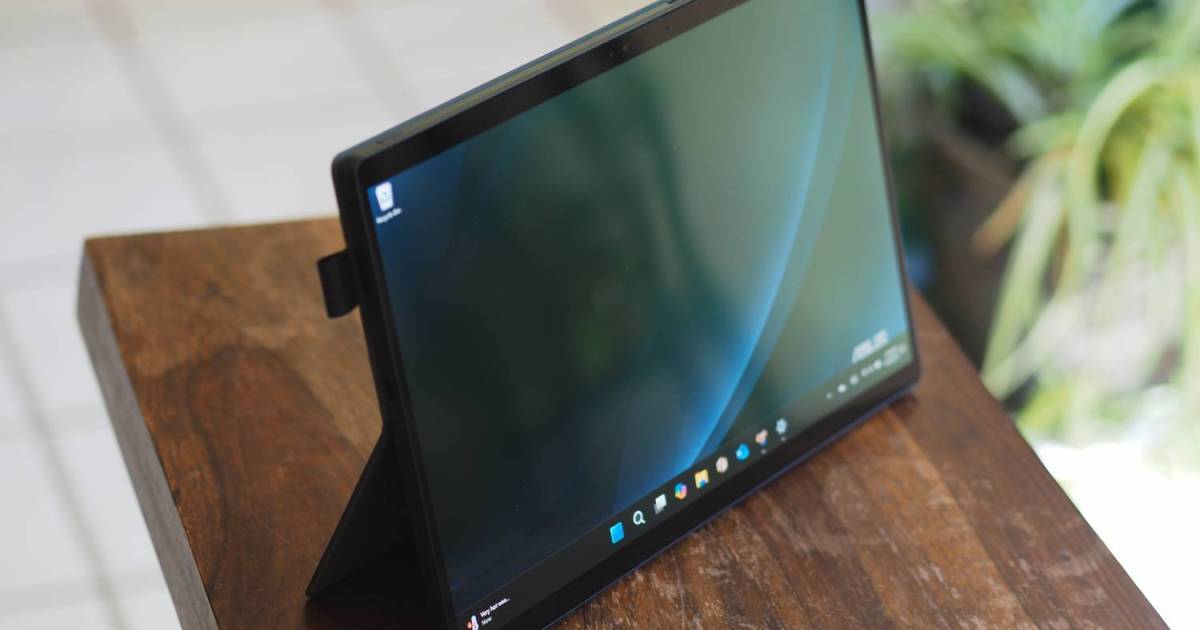The Surface Pro 11 represents Microsoft’s latest generation of its Windows tablet with a detachable keyboard. It’s become a less popular type of 2-in-1 laptop over the last few years, with the 360-degree convertible becoming the dominant form factor. Even so, Microsoft put together a new machine that leverages Qualcomm’s Snapdragon X chipset for great performance and battery life, while retaining what’s always made the Surface Pro great.
Asus has introduced a competitor, the ProArt PZ13, which offers up some real competition. It also has great performance and battery life, except it costs a lot less — upward of $700 less. Is greater value enough to unseat the Surface Pro 11’s place on our list of best 2-in-1s?
Specs and configurations
| Microsoft Surface Pro 11th Edition | Asus ProArt PZ13 | |
| Dimensions | 11.3 inches x 8.2 inches x 0.37 inches | 11.7 inches x 7.9 inches x 0.35 inches |
| Weight | 1.97 pounds (tablet only) | 1.87 pounds (tablet only) |
| Processor | Qualcomm Snapdragon X Plus (10-core) Qualcomm Snapdragon X Elite (12-core) |
Qualcomm Snapdragon X Plus X1P-42-100 |
| Graphics | Qualcomm Adreno | Qualcomm Adreno |
| RAM | 16GB 32GB |
16GB |
| Display | 13.o-inch 3:2 2.8K (2880 x 1920) IPS, 120Hz 13.0-inch 3:2 2.8K (2880 x 1920) OLED, 120Hz |
13.3-inch 16:10 2.8K (2880 x 1800) OLED, 60Hz |
| Storage | 256GB SSD 512GB SSD 1TB SSD |
1TB SSD |
| Touch | Yes, optional pen | Yes, optional pen |
| Ports | 2 x USB4 USB-C Surface Connect NanoSIM |
2 x USB4 1 x microSD card reader |
| Wireless | Wi-Fi 7 and Bluetooth 5.4 Optional 5G |
Wi-Fi 7 and Bluetooth 5.4 |
| Webcam | 1440p front-facing with infrared camera for Windows 11 Hello 10.5MP rear-facing |
5MP front with infrared camera for Windows 11 Hello facial recognition 13MP rear |
| Operating system | Windows 11 | Windows 11 on Arm |
| Battery | IPS: 48 watt-hour OLED: 53 watt-hour |
70 watt-hour |
| Price | $1,000+ | $1,100 |
| Rating | 4.5 out of 5 stars | 4 out of 5 stars |
There’s just one configuration of the ProArt PZ13, coming in at $1,100 with a Qualcomm Snapdragon X Plus chipset, 16GB of RAM, a 1TB SSD, and a 13.3-inch 2.8K OLED display.
The Surface Pro 11 has several options. There’s a version built around a 13.0-inch 2.8K IPS display that starts at $1,000 for a Snapdragon X Plus, 16GB of RAM, and a 256GB SSD. When matched up as closely as possible with the ProArt PZ13 — that is, with an OLED display and the same RAM and storage but with a faster Snapdragon X Elite — the Surface Pro 11 costs $1,700. Upgrade to 32GB of RAM, and you’ll spend over $2,000.
That makes the ProArt PZ13 a significantly less expensive Windows tablet, and as we’ll see, you’re not giving up much in terms of performance and battery life. In addition, Asus includes the keyboard with the ProArt PZ13, which is a $170 option from Microsoft. Active pens are optional with both and cost around $100.
Design
The Surface Pro 11 continues the design that originated the detachable tablet, and it’s about as good as it gets. It’s thin, light, and incredibly well-built, with an all-aluminum chassis, reasonably thin bezels, and a solid feel. The ProArt PZ13 is also all-aluminum and it’s also a solid machine, while being just as thin and light. They’re both simple slates aesthetically, but while the ProArt PZ13 comes only in black, the Surface Pro 11 has four attractive color options. Those extend to the Surface Pro keyboard options, making for a unified look.
The biggest difference in their designs is that the Surface Pro 11 has a built-in kickstand that works exceptionally well and fits within its thin and light form. With the ProArt PZ13, the kickstand magnetically attaches to the back and adds some thickness and weight. It’s also another thing to carry around.
The Surface Pro 11’s keyboard is incredibly well-designed, with a magnetic tilt option that holds it up at an angle, which the ProArt PZ13’s keyboard lacks. Both keyboards have comfortable key spacing and snappy switches, so they are roughly equal in typing feel. The Surface Pro 11’s touchpad is a haptic version, and it’s a better experience than the ProArt PZ13’s mechanical touchpad, which is still very good for what it is. The Surface Pro 11’s Surface Pen 2 has haptic feedback that interacts with the display for a more natural writing and drawing feel. The ProArt PZ13’s active pen doesn’t have the same feature.
Both laptops have the same number of ports, specifically two USB4 connections. The ProArt PZ13 has a microSD card reader while the Surface Pro 11 has a nanoSIM slot for 5G cellular connectivity. Both have Wi-Fi 7 and Bluetooth 5.4.
Finally, each tablet has a high-res webcam and rear-facing cameras, and both have infrared cameras for Windows 11 facial recognition. They both have fast neural processing units (NPUs) supporting faster on-device AI performance and Microsoft Copilot+ PC support.
Performance

Both tablets use Qualcomm’s latest Snapdragon X chipsets. The ProArt PZ13 is limited to the Plus X1P-42-100 version with eight cores running at up to 3.2GHz and boosting up to 3.4GHz, and with an Adreno GPU that runs at up to 1.7 TFLOPS. The Surface Pro 11 can be had with the Plus X1P-64-100 with 10 cores running at 3.4GHz and with a 3.8 TFLOPS Adreno GPU. The faster X Elite X1E-80-100 is also an option, which has 12 cores, runs at up to 3.8GHZ with a 4.0GHz boost, and a 3.8 TFLOPS Adreno GPU.
We reviewed the Surface Pro 11 with the faster chipset, and it was indeed faster than the ProArt PZ13. Its GPU performance was almost twice as fast. In practice, though, the CPU differences aren’t likely to be noticeable, and neither GPU is fast enough for gamers and creators.
| Geekbench 6 (single/multi) |
Cinebench R24 (single/multi/battery) |
3DMark Wild Life Extreme |
|
| Surface Pro 11 (SnapDragon X Elite X1E-80-100) |
2,365 / 13,339 | 124 / 841 | 6,128 |
| ProArt PZ13 (SnapDragon X Plus X1P-42-100) |
2,388 / 11,231 | 108 / 619 | 3,228 |
Display

The Surface Pro 11 has IPS and OLED display options, both 13.0-inch 3:2 2.8K panels running at 120Hz. The ProArt PZ13 has a 13.3-inch 16:10 2.8K OLED display that runs at a slower 60Hz.
We reviewed the Surface Pro 11 with its OLED panel, and it was brighter but less colorful than the ProArt PZ13’s OLED display. Both are excellent displays, with the usual inky blacks. They’re excellent for any users, and make for great streaming media machines. Still, Microsoft has the edge with its faster 120Hz refresh rate.
| Surface Pro 11 (OLED) |
ProArt PZ13 (OLED) |
|
| Brightness (nits) |
532 | 394 |
| AdobeRGB gamut | 85% | 95% |
| sRGB gamut | 100% | 100% |
| DCI-P3 gamut | 97% | 100% |
| Accuracy (DeltaE, lower is better) |
0.74 | 0.98 |
| Contrast | 22,620:1 | 27,520:1 |
Portability

Both tablets by themselves are around the same size, which is to say they’re light enough and thin enough to hold in your hands for digital inking and art — that is, as much as 13-inch tablets can be. As mentioned, the Surface Pro 11 has its kickstand built-in, making it the more portable solution overall.
In terms of battery life, the ProArt PZ13 has a larger battery at 70 watt-hours versus 48 or 53 watt-hours on the Surface Pro, depending on the chipset. It saw less battery life in our web browsing test but more in our video looping and demanding Cinebench multi-core test. Overall, both tablets have great battery life and will last a full day of productivity work.
| Web | Video | Cinebench 2024 |
|
| Surface Pro 11 (SnapDragon X Elite X1E-80-100) |
14 hours, 39 minutes | 16 hours, 26 minutes | 1 hour, 52 minutes |
| ProArt PZ13 (SnapDragon X Plus X1P-42-100) |
12 hours, 37 minutes | 18 hours, 39 minutes | 2 hours, 45 minutes |
The Surface Pro 11 is better, but considerably more expensive
The bottom line is that the Surface Pro 11 is the more-refined tablet, with a more cohesive design and some nice features. It’s faster than the ProArt PZ13, but the Asus is fast enough for most users. Both get very good battery life and enjoy excellent OLED displays.
In the end, it comes down to your budget. You’ll save over $700 after you buy the Surface Pro 11’s keyboard, so the ProArt PZ13 is the more affordable option. Both are excellent Windows tablets that represent the current state of the art.
Read the full article here














